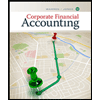
Bundle: Accounting, Loose-Leaf Version, 27th + CengageNOWv2, 1 term Printed Access Card for Warren/Reeve/Duchac?s Financial Accounting, 15th
27th Edition
ISBN: 9781337899451
Author: Carl S. Warren; James M. Reeve; Jonathan Duchac
Publisher: South-Western College Pub
expand_more
expand_more
format_list_bulleted
Question
Chapter 17, Problem 17.2EX
1.
To determine
Vertical Analysis
Vertical analysis is prepared to analyze the relationship among various financial statements with a particular base amount.
Formula:
This analysis is otherwise called as common-size statement.
To prepare: Comparative income statement for the two-year period.
Given info: Income statement for the two year period.
2.
To determine
To comment: Significant relationships revealed by the vertical analysis.
Expert Solution & Answer
Trending nowThis is a popular solution!

Students have asked these similar questions
Provide correct option general accounting question
i need this question answer General accounting
expert of account solve this asap
Chapter 17 Solutions
Bundle: Accounting, Loose-Leaf Version, 27th + CengageNOWv2, 1 term Printed Access Card for Warren/Reeve/Duchac?s Financial Accounting, 15th
Ch. 17 - Prob. 1DQCh. 17 - Prob. 2DQCh. 17 - A companys current year net income (after income...Ch. 17 - How would the current and quick ratios of a...Ch. 17 - Prob. 5DQCh. 17 - What do the following data, taken from a...Ch. 17 - a. How does the return on total assets differ from...Ch. 17 - Kroger, a grocery store, recently had a price-...Ch. 17 - Prob. 9DQCh. 17 - Prob. 10DQ
Ch. 17 - Horizontal analysis The comparative temporary...Ch. 17 - Prob. 17.1BPECh. 17 - Vertical analysis Income statement information for...Ch. 17 - Vertical analysis Income statement information for...Ch. 17 - Prob. 17.3APECh. 17 - Prob. 17.3BPECh. 17 - Accounts receivable analysis A company reports the...Ch. 17 - Accounts receivable analysis A company reports the...Ch. 17 - Inventory analysis A company reports the...Ch. 17 - Inventory analysis A company reports the...Ch. 17 - Prob. 17.6APECh. 17 - Long-term solvency analysis The following...Ch. 17 - Times interest earned A company reports the...Ch. 17 - Times interest earned A company reports the...Ch. 17 - Asset turnover A company reports the following:...Ch. 17 - Asset turnover A company reports the following:...Ch. 17 - Return on total assets A company reports the...Ch. 17 - Return on total assets A company reports the...Ch. 17 - Common stockholders profitability analysis A...Ch. 17 - Common stockholders profitability analysis A...Ch. 17 - Prob. 17.11APECh. 17 - Prob. 17.11BPECh. 17 - Prob. 17.1EXCh. 17 - Prob. 17.2EXCh. 17 - Common-sized income statement Revenue and expense...Ch. 17 - Vertical analysis of balance sheet Balance sheet...Ch. 17 - Horizontal analysis of the income statement Income...Ch. 17 - Current position analysis The following data were...Ch. 17 - Prob. 17.7EXCh. 17 - Current position analysis The bond indenture for...Ch. 17 - Accounts receivable analysis The following data...Ch. 17 - Accounts receivable analysis Xavier Scores Company...Ch. 17 - Inventory analysis The following data were...Ch. 17 - Inventory analysis QT, Inc. and Elppa Computers,...Ch. 17 - Ratio of liabilities to stockholders equity and...Ch. 17 - Ratio of liabilities to stockholders equity and...Ch. 17 - Ratio of liabilities to stockholders equity and...Ch. 17 - Prob. 17.16EXCh. 17 - Profitability ratios The following selected data...Ch. 17 - Profitability ratios Ralph Lauren Corporation...Ch. 17 - Six measures of solvency or profitability The...Ch. 17 - Five measures of solvency or profitability The...Ch. 17 - Prob. 17.21EXCh. 17 - Prob. 17.22EXCh. 17 - Earnings per share, discontinued operations The...Ch. 17 - Prob. 17.24EXCh. 17 - Prob. 17.25EXCh. 17 - Prob. 17.1APRCh. 17 - Prob. 17.2APRCh. 17 - Prob. 17.3APRCh. 17 - Measures of liquidity, solvency, and profitability...Ch. 17 - Solvency and profitability trend analysis Addai...Ch. 17 - Prob. 17.1BPRCh. 17 - Prob. 17.2BPRCh. 17 - Effect of transactions on current position...Ch. 17 - Measures of liquidity, solvency and profitability...Ch. 17 - Solvency and profitability trend analysis Crosby...Ch. 17 - Financial statement analysis The financial...Ch. 17 - Prob. 17.1CPCh. 17 - Prob. 17.3CPCh. 17 - Common-sized income statements The condensed...Ch. 17 - Profitability analysis Deere Company manufactures...Ch. 17 - Comprehensive profitability and solvency analysis...
Knowledge Booster
Similar questions
- General accountingarrow_forwardSunset Industries has a debt-to-equity ratio of 1.25, a ROA (Return on Assets) of 7.5%, and total equity of $800,000. What are the company's equity multiplier, debt ratio, and ROE? (Round equity multiplier to 2 decimal places, debt ratio to 3 decimal places, and ROE to 1 decimal place.)arrow_forwardWhat is its return on equity ROE?arrow_forward
arrow_back_ios
SEE MORE QUESTIONS
arrow_forward_ios
Recommended textbooks for you
 Managerial AccountingAccountingISBN:9781337912020Author:Carl Warren, Ph.d. Cma William B. TaylerPublisher:South-Western College Pub
Managerial AccountingAccountingISBN:9781337912020Author:Carl Warren, Ph.d. Cma William B. TaylerPublisher:South-Western College Pub Corporate Financial AccountingAccountingISBN:9781337398169Author:Carl Warren, Jeff JonesPublisher:Cengage Learning
Corporate Financial AccountingAccountingISBN:9781337398169Author:Carl Warren, Jeff JonesPublisher:Cengage Learning Financial AccountingAccountingISBN:9781337272124Author:Carl Warren, James M. Reeve, Jonathan DuchacPublisher:Cengage Learning
Financial AccountingAccountingISBN:9781337272124Author:Carl Warren, James M. Reeve, Jonathan DuchacPublisher:Cengage Learning Managerial Accounting: The Cornerstone of Busines...AccountingISBN:9781337115773Author:Maryanne M. Mowen, Don R. Hansen, Dan L. HeitgerPublisher:Cengage Learning
Managerial Accounting: The Cornerstone of Busines...AccountingISBN:9781337115773Author:Maryanne M. Mowen, Don R. Hansen, Dan L. HeitgerPublisher:Cengage Learning

Managerial Accounting
Accounting
ISBN:9781337912020
Author:Carl Warren, Ph.d. Cma William B. Tayler
Publisher:South-Western College Pub

Corporate Financial Accounting
Accounting
ISBN:9781337398169
Author:Carl Warren, Jeff Jones
Publisher:Cengage Learning

Financial Accounting
Accounting
ISBN:9781337272124
Author:Carl Warren, James M. Reeve, Jonathan Duchac
Publisher:Cengage Learning

Managerial Accounting: The Cornerstone of Busines...
Accounting
ISBN:9781337115773
Author:Maryanne M. Mowen, Don R. Hansen, Dan L. Heitger
Publisher:Cengage Learning